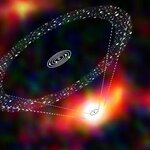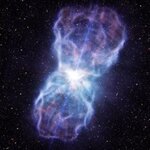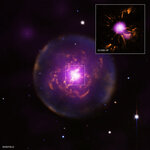Space

A monster black hole has been detected. With 17 billion solar masses, it is significantly heavier than models predict and could be the most massive black hole known to date.
Astronomers believe there is a super-massive black hole at the heart of every galaxy and its mass ranges from several hundred thousand solar masses to a few billion. The black hole that has been best investigated sits at the center of our galaxy, the Milky Way, and has around four million solar masses.
Studies of the masses of distant galaxies and their black holes have turned up an interesting…

NASA's Cassini spacecraft has been orbiting Saturn since 2004 so it has seen a lot - but it recently saw something that has not happened since 1997.
Seasonal atmospheric circulation direction changes on Titan, technically only a moon but bigger than the planet Mercury, happen only once every 15 years and are never observable from Earth. Titan is the only known moon to have a significant atmosphere and is one of only four terrestrial atmospheres in our Solar System - the others being Venus, Mars and obviously Earth. Since Titan's rotation axis is tilted similar to Earth, it…

Astronomers have discovered vast comet belts surrounding two nearby planetary systems – GJ 581 and 61 Vir – known to host only Earth-to-Neptune-mass worlds. Previously, scientists found that the dusty belt surrounding nearby star Fomalhaut must be maintained by collisions between comets.
Herschel detected the signatures of cold dust at 200ºC below freezing, in quantities that mean these systems must have at least 10 times more comets than in our own Solar System's Kuiper Belt. GJ 581, or Gliese 581, is a low-mass M dwarf star, the most common type of star in the Galaxy. Earlier…

A jet of X-rays from the supermassive black hole in quasar
GB 1428+4217, 12.4 billion light years from Earth, has been detected by NASA's Chandra X-ray Observatory - the most distant X-ray jet ever observed.
Giant black holes at the centers of galaxies can pull in matter at a rapid rate producing the quasar phenomenon. The energy released as particles fall toward the black hole generates intense radiation and powerful beams of high-energy particles that blast away from the black hole at nearly the speed of light. These particle beams can interact with magnetic fields or ambient…

Quasars are the luminous centers of distant galaxies powered by huge black holes. Although black holes are noted for pulling material in, most quasars also accelerate some of the material around them and eject it at high speed.
Many theoretical simulations suggest that the impact of these outflows on the galaxies around them may resolve several enigmas in modern cosmology, including how the mass of a galaxy is linked to its central black hole mass, and why there are so few large galaxies in the Universe. However, whether or not quasars were capable of producing outflows powerful enough…

NASA's Cassini mission has spotted a second feature shaped like the 1980s video game icon Pac-Man, this time on Saturn's moon Tethys.The pattern appears in thermal data obtained by Cassini's composite infrared spectrometer, with warmer areas making up the Pac-Man shape.
Scientists theorize that the Pac-Man thermal shape on the Saturnian moons occurs because of the way high-energy electrons bombard low latitudes on the side of the moon that faces forward as it orbits around Saturn. The bombardment turns that part of the fluffy surface into hard-packed ice. As a result, the altered surface does…

And now the news from Alpha Centauri…(Oh, I’ve waited for so long to utter those words! News. From Alpha Centauri. Wow!)
After an incredible decade, in which the number of planets known beyond our solar system increased from zero to several hundred, with a couple of thousand potential "hits" still to verify, astronomers have now detected a roughly Earth-sized world orbiting between the two stars nearest to our system, Alpha Centauri A and Alpha Centauri B. Much too hot to sustain life, it nevertheless will help in narrowing down the search space for…

The dwarf planet Makemake is about two thirds of the size of Pluto and farther from the Sun - but closer than Eris, the most massive so-called dwarf planet in the Solar System after the confusing reconfiguration by the International Astronomical Union that said Pluto was not a planet but then was, only a special non-planet along with others.
Like Eris, but unlike Pluto, Makemake has no atmosphere, making it even less sensical as a planet.
To determine this, researchers combined multiple observations using three telescopes at ESO's La Silla and Paranal observing sites in Chile; the Very Large…

The Exoplanet next door: Astronomers have discovered the lowest-mass planet yet orbiting a Sun-like star. But the even-more exciting news is that it orbits α Centauri B, a member of the stellar system that is our Solar System’s nearest neighbour. Although nearly identical to Earth in mass, the planet is much closer to its star than Mercury is to the Sun, meaning that it is likely a scorched and barren rock. Nevertheless, its astronomical proximity to Earth will undoubtedly stir dreams of interstellar exploration, particularly as astronomers search α Centauri for more…

The planetary nebula Abell 30 is located 5,500 light-years from Earth and it has given astronomers a lookl at a dying Sun-like star that came briefly back to life after giving up the stellar ghost, mimicking the possible fate our own Solar System faces in a few billion years.. ‘Planetary nebula’ is the name given to the often-concentric shells of stellar material cast into space by dying stars. To astronomers of the 18th century, these objects looked like the colorful ‘blob’ of a planet through their telescopes, and the name stuck. Astronomers now know that as a star with less than…